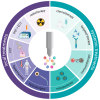Gas Plasma Combination Therapies-Promises from Preclinical Oncology Research
- PMID: 41008962
- PMCID: PMC12466764
- DOI: 10.3390/antiox14091055
Gas Plasma Combination Therapies-Promises from Preclinical Oncology Research
Abstract
The absent decline in cancer mortality rates is primarily due to moderate therapeutic efficacy and intrinsic or acquired tumor cell resistance toward treatments. Combining different oncology treatments increases therapy success and decreases the chance of refractory tumor cells. Therefore, combination cancer treatments are the principal paradigm of 21st-century oncology. Physical modalities such as radiotherapy have a long-standing tradition in such combination treatments. In the last decade, another physical principle emerged as a promising anticancer agent: cold gas plasma. This partially ionized gas, operated at about body temperature, emits multiple bioactive components, including reactive oxygen and nitrogen species (ROS/RNS). This technology's multi-ROS/RNS nature cannot be phenocopied by other means, and it capitalizes on the vulnerability of tumor cells within metabolic and redox signaling pathways. Many cancer models exposed to mono or combination gas plasma treatments have shown favorable results, and first cancer patients have benefited from cold gas plasma therapy. The main findings and proposed mechanisms of action are summarized. Considering the specific application modes, this review identifies promising gas plasma combination therapies within guideline-directed treatment schemes for several tumor entities. In conclusion, gas plasmas may become a potential (neo)adjuvant therapy to existing treatment modalities to help improve the efficacy of oncological treatments.
Keywords: CAP; LTP; NTP; chemotherapy; drugs; electrochemotherapy; immunotherapy; ionizing radiation; photodynamic therapy; plasma medicine; radiotherapy.
Conflict of interest statement
The authors declare no conflict of interest.
Figures




References
-
- Winther S.B., Liposits G., Skuladottir H., Hofsli E., Shah C.H., Poulsen L.O., Ryg J., Osterlund P., Berglund A., Qvortrup C., et al. Reduced-dose combination chemotherapy (S-1 plus oxaliplatin) versus full-dose monotherapy (S-1) in older vulnerable patients with metastatic colorectal cancer (NORDIC9): A randomised, open-label phase 2 trial. Lancet Gastroenterol. Hepatol. 2019;4:376–388. doi: 10.1016/S2468-1253(19)30041-X. - DOI - PubMed
-
- Panahi Y., Saadat A., Beiraghdar F., Hosseini Nouzari S.M., Jalalian H.R., Sahebkar A. Antioxidant effects of bioavailability-enhanced curcuminoids in patients with solid tumors: A randomized double-blind placebo-controlled trial. J. Funct. Foods. 2014;6:615–622. doi: 10.1016/j.jff.2013.12.008. - DOI
Publication types
LinkOut - more resources
Full Text Sources
Miscellaneous

